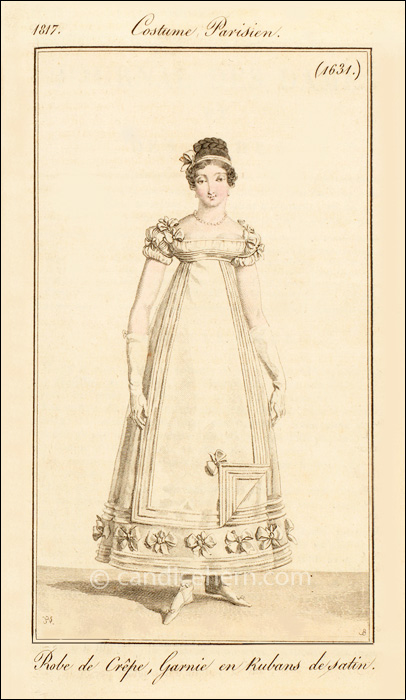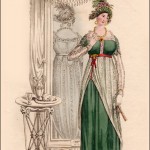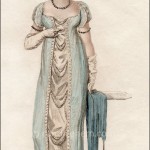Ackermann’s Repository of Arts, April 1817.
“Parisian Ball Dress.”
By 1817, skirts have become slightly wider in the bell shape that will dominate the 1820s. The hems are also higher with evening dresses, especially ball dresses which are typically shown shorter for ease of dancing. And also, perhaps, to better display elegant dancing slippers. The waistlines for evening dresses are very high at this time, and will continue so for the next 2 years or so before they slowly start to descend toward the natural waist.
The print is described in the magazine as follows:
“A frock of white tulle over a white satin slip; the upper part of the body is formed of a piece of tulle set in full, the lower part plain, and ornamented by three rows of white satin, which form a cestus. The sleeve very short and full, is ornamented also by rolls, which are placed byas across the arm, and finished in the middle by a bow of ribbon. Two bows of ribbon are placed, one on the middle, the other at the end of the shoulder-strap, in front. The bottom of the skirt is trimmed with three rows of white satin, above which are placed bows of ribbon at regular distances, and they are surmounted by a triple row of rolls. An apron of tulle, trimmed with pointed blond, give an elegant finish to the dress: it is much wider at the bottom than the top, and is sufficiently short to display the trimming of the dress. The hair is dressed very light and low on the temples in front, and the hind hair braided and brought round the crown of the head. It is ornamented only with a band and bow of white satin. White satin slippers. White kid gloves, finished by bows of ribbon at the top.”
This print was copied from the Parisian magazine Journal des Dames et des Modes, March 5, 1817. Though Ackermann’s doesn’t credit the French publication, at least they title the print “Parisian Ball Dress.”
Normally, when British magazines “borrow” prints from Journal des Dames et des Modes, the prints are almost identical to the French originals, with sometimes minor changes, especially adding backgrounds or furniture. Faces are also frequently transformed, perhaps to provide a more “English” look. And here we see the beautifully rendered face typical of Ackermann. But in this print there has been a rather significant change to the dress, which is unusual. The simple trimming of the apron in the French print has been transformed with beautiful pointed lace in the Ackermann print, and it is not pinned up in one corner. All other elements of the original French dress have remained intact.









